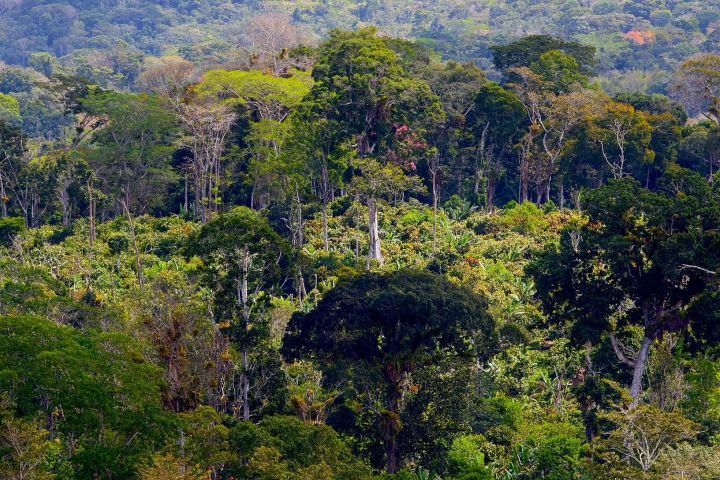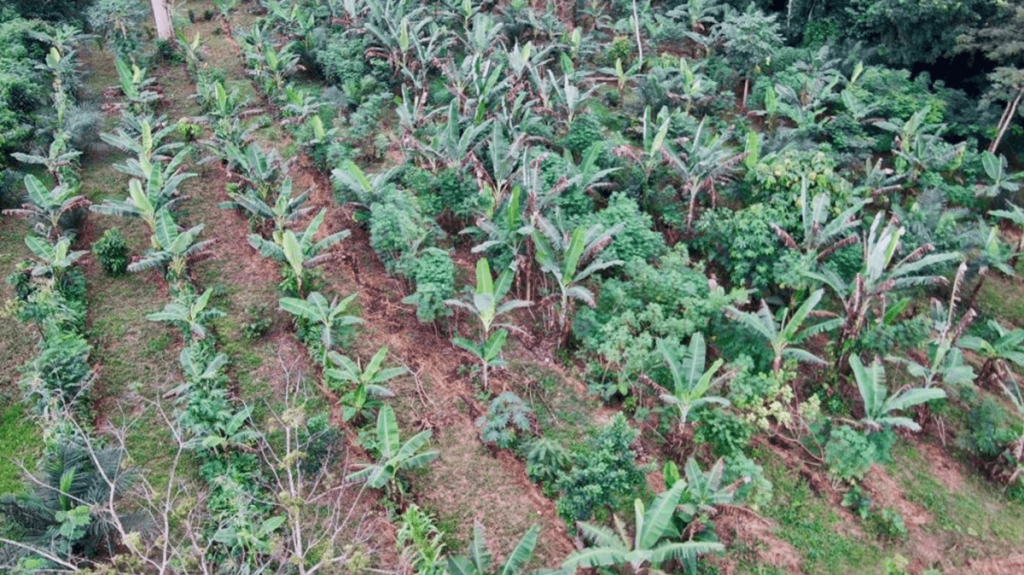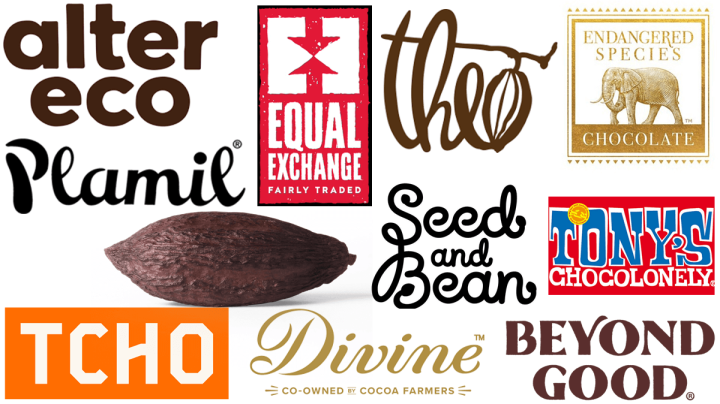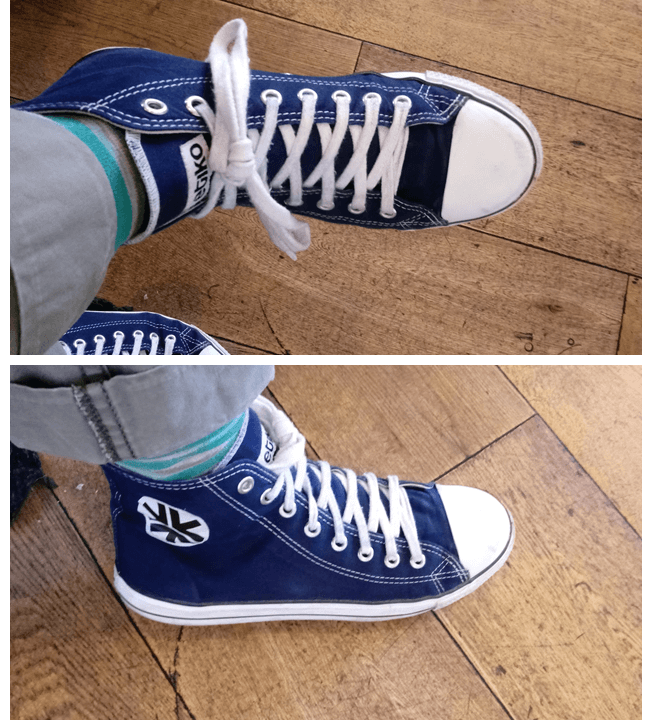Agroforestry involves the integration of forestry and agriculture – in other words, growing a crop while maintaining native tree life, as much as possible. In many scenarios the agricultural crop grows on small trees under the partial shade of taller native trees – for example, cacao and coffee beans. In other cases, crops can be grown on the ground among trees – such as legumes grown in between fruit trees. The idea, as you can probably guess, is to maintain the many benefits of forests while growing crops for human use.

Here are a few more precise definition of Agroforestry, from a 2022 review titled, An appraisal of agroforestry studies in Sub-Saharan Africa:
1977–1987 is described as the ‘decade of agroforestry development’. The era saw the proper definition of the term agroforestry in 1977 as a ‘land use practice where trees are grown on farms in a spatial, temporal or rotation arrangements’ to achieve ecological and economic benefits to the farmers.
Potential ecosystem benefits include enhanced biodiversity conservation, water quality regulation, soil and air quality, and control of pests and diseases, while simultaneous livelihood needs may include income generation, economic stabilization, food security, and livelihoods diversification.

The images above show two extremes of agroforestry, from cacao trees living in the wild Amazon to an orderly arrangement of fruit trees and other crops in Bangladesh. Most cases will probably lie somewhere in between these two examples, with a sprinkling of native trees providing a moderate level of shade cover and habitat for native wildlife. Agroforestry can be applied anywhere, but it’s especially valuable in the tropical forests of Sub-Saharan Africa, South America, and Asia. These tropical forests play crucial roles in biodiversity and capturing CO2 from the atmosphere and must be preserved, at all costs. Take a look at how often maintenance of our forests turns up as a solution to climate change…
Project Drawdown and forests
If you are not familiar with Project Drawdown’s prioritized list of climate change solutions, it’s worth taking a look. The solutions are ranked according to how much they reduce greenhouse gas emissions and you’ll see some familiar ideas at the top of the list: wind, solar, plant-based diets, and reducing food waste. But look how often forests feature in the top 20 solutions:
- Tropical Forest Restoration
- Silvopasture
- Peatland Protection and Rewetting
- Tree Plantations (on Degraded Land)
- Perennial Staple Crops
- Temperate Forest Restoration
- Tree Intercropping
- Multistrata Agroforestry
Multistrata agroforestry systems mimic the structure of natural forests. Layered trees and crops achieve high rates of both carbon sequestration and food production.”
Over a third of Drawdown’s top 20 solutions are forest-related and most of these either involve agroforestry directly (in bold, above) or would benefit from it. The goal of forest restoration becomes more likely to succeed in some regions if restored forests can also generate some income for locals (the forest that pays stays).
The topic of agroforestry came up again recently as I was researching the sustainability of Dr. Bronner’s soaps for a post on Ethical Bargains. Here’s more of Dr. Bronner’s work on agroforestry, and then I’ll give some other examples of how to support agroforestry as a consumer.
Dr. Bronner’s and Dynamic Agroforestry
Staff at Dr. Bronner’s, always on the lookout for projects that improves the social and environmental impact of its products, were introduced to Dynamic Agroforestry (DAF) in late 2016.
Planted on a degraded pineapple plantation, the orchard featured regular parallel rows of densely and diversely planted trees and ground crops. Cocoa, oil palm, and rubber were the main crops; fruit, cashew nut, and timber trees were included at a lower density; fast-growing bananas and papayas still dominated the picture during these early years.
Some of Dr. Bronner’s products include palm oil – a product that can devastate forests unless ethically-sourced (and RSPO certification is not good enough). Change is badly needed here so it’s very helpful to seek out companies that go out of their way to source sustainable palm oil, such as those partnered with Palm Done Right (Dr. Bronner’s is one of several soap companies that qualify). Dr. Bronner’s has a Ghanaian sister company, Serendipalm, that supplies sustainable palm oil and has now working towards promoting DAF in Ghana.
Serendipalm established its own DAF training and demonstration farms, a 15-acre farm near Asuom and a 7.5-acre farm near Abaam. Next, we started trials with some of our farmers and, by late 2019, had helped some twenty-five to install small trial plots on their farms.

In 2022, Dr. Bronner’s partnered with Ecosia, the nonprofit search engine that fund tree-planting projects, to fund a larger organic DAF program in Ghana.
This project will convert 200 acres of arable land in Ghana to a mixed dynamic agroforestry model for product and full-scale demonstration of the concept to farmers and visitors.
This will help equip and empower the rural community near Asuom, Ghana with the tools to diversify their crops, expand farmer incomes, and improve food security in the community while sequestering carbon in soil and trees, thus helping mitigate climate change impacts.
I believe that the adoption of agroforestry should be one of our top priorities, particularly when combined with equitable trade to alleviate poverty and enrich communities. This aligns with two of Dr. Bronner’s ethical standards – sustainable agriculture and fair trade (I scored Dr. Bronner’s 5/5 Green Stars for social and environmental impact). Let’s take a look at some other examples.
How to support agroforestry as a consumer
Besides Dr. Bronner’s, which brands and companies should we choose if we want to support the more widespread adoption of agroforestry? Although the concept took off in the 1970’s, agroforestry is not yet a widespread practice. Instead multinational corporations continue to exploit both the tropical forests and the people of the Global South. Certain industries are more at fault here – particularly meat (animal feed is a major cause of deforestation) and companies that buy tropical products such as cocoa and coffee on commodity markets. As consumers, the preservation of forests usually entails the avoidance of brands from multinational corporations and seeking out good players, which are often smaller companies.
Chocolate and agroforestry
In West Africa, cacao farming has reduced tropical rainforest coverage, including protected national forests. However, as discussed in chocolate and deforestation, cacao trees can actually be grown under at least 30% shade cover with no loss in yield (and offering multiple environmental benefits). One company discussed in that post, Beyond Good, reports on the percentage of non-cacao trees on supplier farms in Madagascar, and this averages at around 25%. I rated Beyond Good chocolate 5/5 green Stars for social and environmental impact. Also, check out my post on the top 10 ethical chocolate brands and please join in by voting for your favorite! Personal favorites include Equal Exchange, Theo, and Alter-Eco.

You’ve probably heard of Smithsonian bird-friendly certification for coffee (see below) but in 2023 the institute also launched a bird-friendly cacao program. Initial chocolate maker partners for this program include Dandelion Chocolate (San Francisco), Raaka Chocolate (Brooklyn) and French Broad Chocolates (Asheville, North Carolina). To qualify, bird-friendly farms must be organic and also provide a sufficient level of shade cover to provide a habitat for birds (and other species).
Most of the globally-recognized, bestselling chocolate products are made from cocoa bought on commodity markets that allow the most unethical practices such as deforestation, poverty, and slavery to continue. Avoid them and instead seek out ethical (shade-grown) chocolate – the benefits to the planet and society make it really worth the effort.
Coffee and agroforestry
Shade-grown coffee is probably the most recognized product that’s compatible with agroforestry (but can also be grown as a full-sun monoculture). I’ll refer you to an earlier post on the topic of shade-grown coffee that looks at various certifications that apply to some extent. The gold standard to look out for in terms of coffee certifications is bird-friendly (which includes organic), certified by the Smithsonian Migratory Bird Center. On the Smithsonian site you can look through the 180 bird-friendly certified coffees and also narrow them down through other criteria (e.g., fair trade, single origin). There are also other notable coffee brands, such as Equal Exchange that, although not Smithsonian-certified, do source shade-grown coffee beans.
Over 98% of Equal Exchange coffees are certified organic by volume. The overwhelming majority of these organic coffees are shade grown – Equal Exchange

Soap and agroforestry
Soaps and detergents can be made from petrochemicals (synthetic detergents) or from plant oils such as palm, olive, and coconut. I do like to buy soaps and detergents made from plant oils, which are renewable, rather than from petroleum, which is not. But I avoid the largest corporations (Unilever, P&G, etc.), which tend to use commodity market palm oil. Besides the recommendation above for Dr. Bronner’s and the soap makers that have partnered with Palm Done Right, check out my post on how to find ethical soap.

Rubber (shoes) and agroforestry
Like detergents, rubber can either be made from petroleum or sourced naturally. Natural rubber is made from latex that’s tapped from rubber trees growing wild in the Amazon rainforest or farmed in other tropical regions such as Southeast Asia. Like palm oil, we need to be careful about sourcing rubber to make sure it doesn’t lead to deforestation. A study published in Nature last year found that rubber is responsible for more deforestation in Southeast Asia than previously thought. As the principal investigator for that study pointed out, it’s important to consider the nuances of the situation; rubber harvested from trees can be positive for society and the planet, if done right.
Rubber is a really good income source for smallholders, if it can be managed properly. It can store between 50 to 250 tonnes of carbon per hectare.
One way to seek out more responsible source of rubber is to find companies that have developed equitable relationships with suppliers. I previously wrote a post on vegan shoes from Etiko, which sources sustainably harvested rubber for its fair trade certified hi-tops.
Etiko uses FSC-certified rubber that’s tapped in Sri Lankan forests for their high top sneakers and incorporates recycled rubber into some of their other products.
The sustainable harvest of products from rainforest can help preserve the forests and give locals and alternative to leaving their home (or leveling it to switch to cattle ranching). It is important to check that the company provides some assurance on sustainability of their supply chain, such as FSC-certification.

Also of note, Veja makes shoes from rubber sourced from the rubber tappers in the Amazon rainforest through a fair trade program.
The “Fair for Life” standard guarantees, among other things, long-term and direct trade relationships, fair prices, good working conditions, and the prohibition of forced labor.
You might rightly wonder: how does fair trade relate to encouraging agroforestry and avoiding deforestation?
Agroforestry: does buying fair trade or organic help?
In the example above, Veja supports a better wage for the Amazonian rubber tappers that allows them to make a living while working in something close to native rainforest. Beyond Good chocolate serves as another good example: farmers began improving their environment, once they were paid a decent wage. We can’t expect locals to improve the forests of the Global South while living in poverty. So, seeking fair trade certified products can absolutely help preserve forests and encourage various forms of agroforestry. A fair trade product also makes the supply chain more transparent than commodity markets, where market price dips are brutal to farmers.
Choosing organic products can also help preserve forest integrity and biodiversity, even though this certification doesn’t stipulate a specific amount of shade cover. Some shade cover makes sense on an organic farm even from a purely economic point of view – the leaf litter from the upper canopy provides an organic fertilizer for crops such as coffee. See this post on shade-grown coffee for more details on how various certifications, including Rainforest Alliance, impact shade cover. Even without the possibility of more shade cover, organic farming offers the significant benefit that pesticides aren’t being used in the forest. (Pesticides for some forestry products such as cacao can be especially nasty.)
Nuts and fruit and agroforestry
A 2022 paper in the journal Lancet Public Health emphasized the importance of food systems that rely on trees and forests. The authors pointed out that we normally think of wood as the main forest product but actually a lot of our food – all nuts and 50% of fruit – grows on trees.
Forests are an especially important source of food and income for the 1·6 billion people (20% of the global population) that live within 5 km of them. Therefore, a critical action for consumers is to support a living for these people while maintaining the integrity of the forests. When you want to buy a product that you think comes from a forest, especially a tropical forest, the right choice is not always obvious. But for many items, such as nuts and fruit, choosing a product that’s certified organic and/or fair trade is a good start.
If you’re interested in ethical consumption, climate change, food sustainability, plant-based food, etc., consider subscribing to my other blog, Ethical Bargains.
Discover more from The Green Stars Project
Subscribe to get the latest posts sent to your email.

Just to widen the picture, here’s a paper from ScienceDirect: https://www.sciencedirect.com/science/article/pii/S0743016721000164
LikeLiked by 1 person